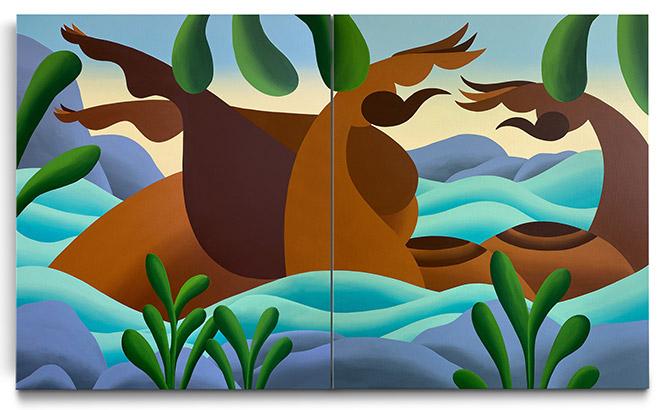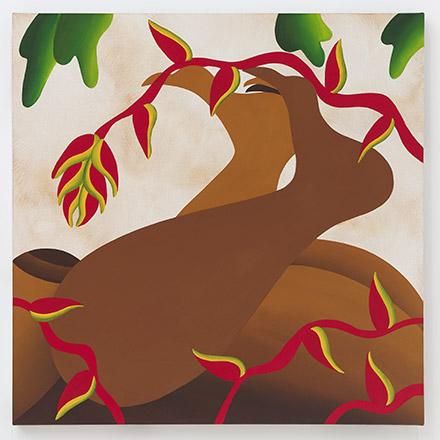Bianca Nemelc Paints the Spiritual Bonds Between Womanhood and Nature
We invited Jasmin Hernandez, founder and editor in chief of Gallery Gurls, to spotlight a living artist who takes inspiration from our collection.
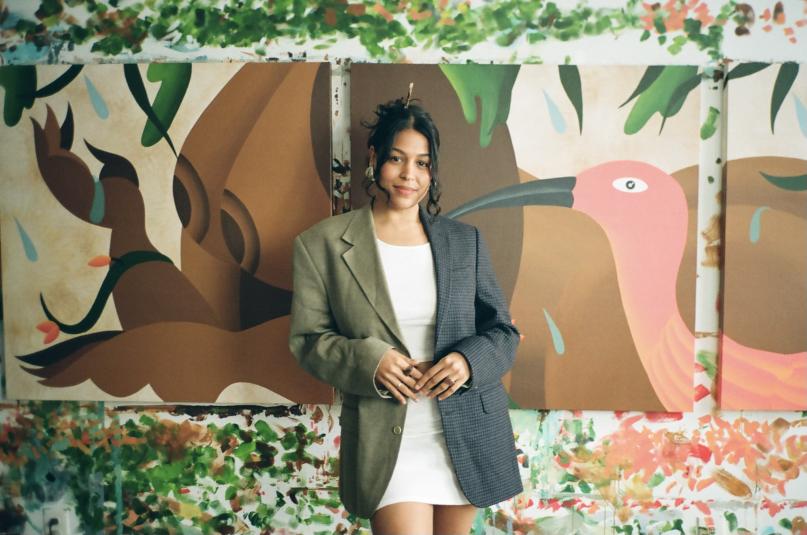
Bianca Nemelc is a figurative painter whose vibrant works intimately explore her familial homelands: the Caribbean, South America, and Indonesia—as well as her birthplace, New York City. Nemelc is Dominican, Indonesian, and Surinamese, and her pan-ethnic identity informs her art. She explores the many personal meanings of homelands, pulling both from imagination and memories. “I trust this land, so I will rest on it,” the young artist says.
Nemelc creates lively acrylic paintings that bloom with sensuality. In lush landscapes, full-figured women of color lie on bright flower beds or dive into turquoise waters. The images are vibrant, but soothing. They evoke feelings of freedom and tranquility. The beaches, forests, and mountains in her colorful canvases belong as easily in the Caribbean, Indonesia, and South America. Through her signature tropical environments, Nemelc explores spiritual connections between nature, migration, rest, and femininity.
Her thick-bodied Brown femme figures celebrate deep bonds between the earth and womanhood. Many times, the hills and mountains blur with their curves, blending to show oneness.
Essential, Ecstatic Rest
Nemelc’s paintings highlight rest, an ecstatic rest. Her femme subjects are often swimming, floating, or reclining, yet all in repose. Nemelc “loves the idea of rest as an active, intentional state of being for the figures in my work.” According to her, “Rest can be something extremely sacred and powerful.”
In The Dive, a Brown femme figure falls through the sky in a relaxed setting. The clouds, leaves, and peach-colored tulips in the dreamy painting feel like a cushion around her body. The figure is carefree because a soft landing awaits. She knows the land will protect her. Nemelc reveals that she “sees joyful rest as a sign of trust in one’s surroundings. It is an act of meditation, an act of reclamation and rebirth.”
In the triptych Family Reunion, a Brown figure lays on her stomach as rain drops fall. Maybe the rain, sun, tree leaves, and flamingo that surround her become her family because of her emotional alignment with nature and wildlife. “In society, rest is a lot of times seen as an unproductive act, there is a guilt in not doing ‘enough,’ when simply existing is a spiritual experience in itself,” the artist explains.
Nemelc follows a tradition of Latin American women artists whose powerful works depicted women in surrealist nature settings. Renowned Mexican photographer Lola Álvarez Bravo photographed both working-class Indigenous women and privileged artist friends like Frida Kahlo and Isabel Villaseñor in Mexico's spellbinding landscapes.
In El Ensueño (Isabel Villaseñor), Álvarez Bravo shows Villaseñor in an otherworldly pose. Reclining across dark tree trunks in a dream state, Villaseñor seems to be almost levitating. It’s an image of ecstatic rest, finding bliss in quietude and stillness.
A Caribbean Body Politic
In Nemelc’s Tender Swim, a femme figure floats in azure waves that seem rich, resplendent, and healing. “Caribbean people have an innate connection to the land and the ocean, and the earth almost plays the role of a protective guiding force,” which Nemelc thinks “is very magical.” Taínos, the Indigenous peoples of the Dominican Republic, Haiti, and other Caribbean islands, have always found sacredness in water. Their two main zemis (deities in Taíno religion) are Atabey, the ancestral mother of the moon, fresh waters, and fertility, and her son Yúcahu, a divine being of the cassava plant (the Taínos’ primary crop) and the sea.
“Water is a recurring theme for me,” Nemelc says. “I use it as a gateway to explore other facets of landscape.”
The artist has found common ground with the late Ana Mendieta, a Cuban-born feminist artist. Mendieta was also a Latina artist from the Spanish-speaking Caribbean. Working in photography and film, she too focused on the femme body and the earth.
Mendieta believed in returning to the land, which she called a “maternal source.” And Nemelc agrees on their mutual ideas around “cultural body politics, migration, displacement, and a shared belief that the earth is the ultimate place of belonging.” Through the shapely women on her canvases, Nemelc has defined a Caribbean body politic: her femme figures represent the everyday curvy body type of Black, Brown, and mixed-race women in the Caribbean.
“One of the biggest connections in my mind, especially with Mendieta’s Silueta series, is the desire to understand identity and place through our practices,” Nemelc says. In her Secret Between Muses, limbs of curvaceous Brown women surrounded by tropical flora tenderly connect with each other and with the soil.
The Earth as a Womb
The Silueta (silhouette) series was both performance and land art. Mendieta’s body (or her body’s imprint) was silhouetted against the landscape covered with a wide mix of items, including rocks, sticks, cloth, and blood.
Nemelc describes these two photographs as “almost ghostly meditations on what it means to exist as a woman, as human on the earth. It’s all very fleeting.”

In the 1979 work, Mendieta carved herself into a dry, patchy landscape, uniting her soul with the dirt. In the other image, twigs and dark seaweed outline a femme spirit. “She created space for her body, and in an act of impermanence, allowed the earth to move on as it wished,” Nemelc shares.
Mendieta made these deeply personal interventions with nature in Mexico and Iowa. In her very first Silueta work from the early 1970s, she lay nude in a tomb of the Zapotec, an Indigenous people in Oaxaca, with white flowers over her body. She once said, “I have no motherland, I feel a need to join with the earth, to return to her womb.” That sentiment resonates with Nemelc, who notes that her work exists on the “opposite side of that same spectrum.”
While Mendieta inserted her body or silhouette in the ground, Nemelc paints imagined Brown women connected to the land. “While I’m of the earth, I’m still a woman of color navigating these lands,” Nemelc says, acknowledging that “it adds a layer of complexity that should be spoken about.”

Bianca Nemelc, The Convergence of Things, 2022, Courtesy of the artist
Calming vibes come together in The Convergence of Things: pastel hues, a pretty sky, clouds, and floating figures. It seems symbolic of Nemelc’s many intersections, which also converge and inform her mesmerizing paintings. Nemelc is a multi-ethnic woman of color. She’s a daughter of the Caribbean, Surinamese, and Indonesian diasporas as well as a first-generation Latina and a Dominican York (a Dominican immigrant living in, or Dominican American born in, New York City). She was born and bred in Washington Heights in Upper Manhattan, which is known as “Little Dominican Republic.” Today, she is based further uptown in the Dyckman/Inwood area of New York, a neighborhood where her roots run deep.
“Being that I was born and raised in New York, I had and still have a very special connection to the Hudson River,” Nemelc explains. “The river connects to the ocean that touches land far from where I stand. That is so powerful, especially when navigating what it means to belong somewhere.”
Banner image: Artist Bianca Nemelc with her painting Family Reunion (2023). Photograph by Stephanie Rodriguez.
You may also like
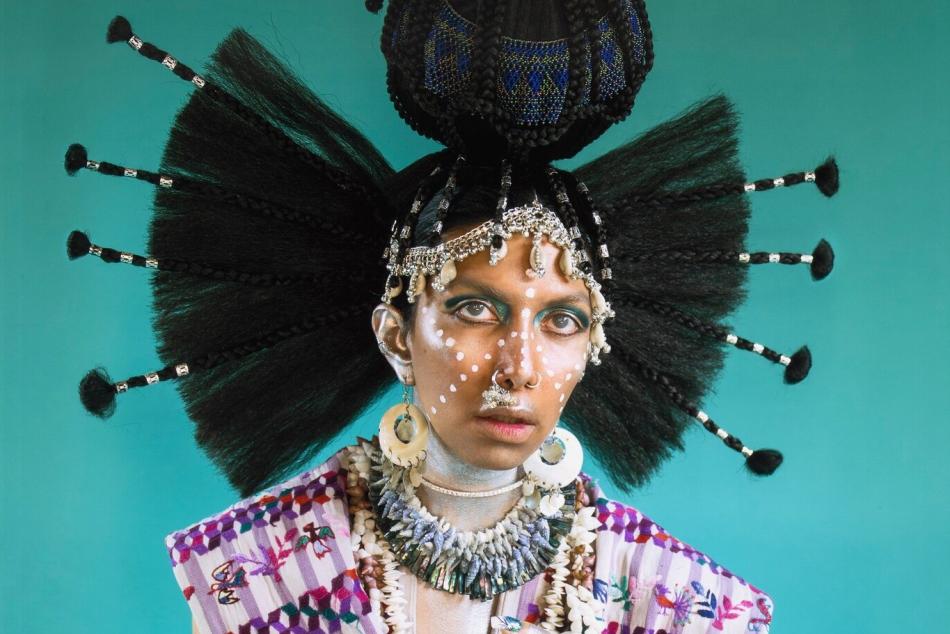
Article: 9 Latinx Artists You May Not Have Heard Of
Learn about the lives and works of artists of Latin American descent working in the United States from the 1930s to today.
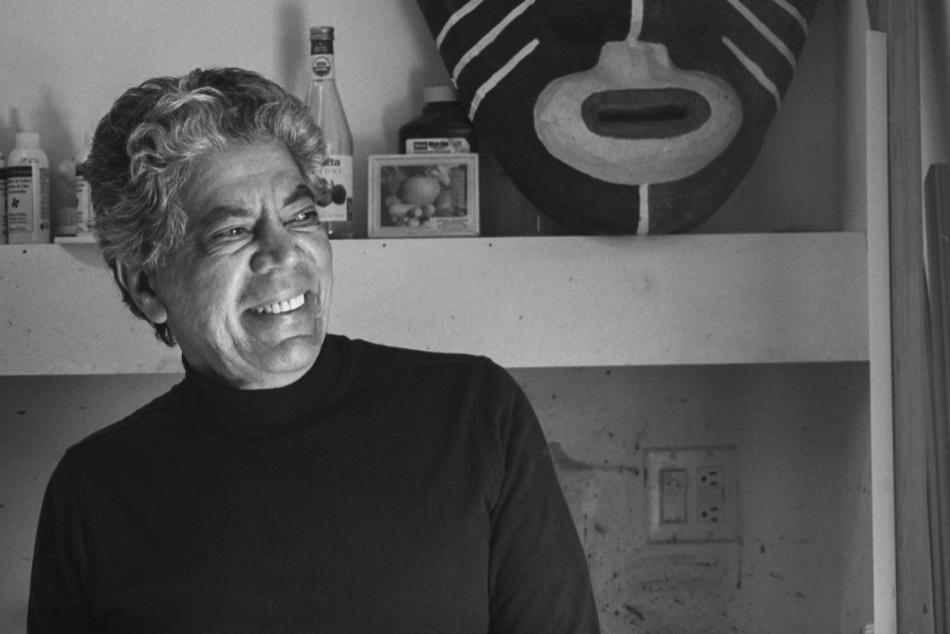
Article: Freddy Rodríguez’s Quest to Express Dominican History in Art
Over 50 years and across many styles and mediums, the artist probed his roots.




